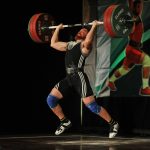by: Lino Cappelli
The vertical jump is one of the pinnacles of athletic ability. Questions such as: “how much can you bench?” or “how fast is your 40?” should always be accompanied by “what is your vertical jump?” Jumping is considered one of the universal physical movements, since it involves triple extension (ie- hips, knees and ankles) and one of the best ways to measure lower body power. A pair of strong legs is much more impressive if they can vertically displace the body an impressive amount.
However the vertical jump has a mortal enemy: gravity. Gravity accelerates pretty quickly, at about 9.8 meters per second per second, which means in order to jump high your body has to be able to generate enough power (the combination of speed and strength) to overcome gravity for as long as possible. Don’t worry though, by combining training methods in a specific order with varying intensity, you will be on your way to gravity defying jumping ability.
In order to effectively improve vertical jump training one must follow the training principles that lay the foundation for every athletic development program: specificity, overload and variability.
- Specificity: We want to increase your vertical jump, so the training has to be specific to the movement planes, rate of force development and muscle systems used in jumping.
- Overload: The body is only as strong as you need it to be; in order for your hops to be astronomical you are going to have to be able to move increasingly heavier weight, increasingly quicker.
- Variability: Eventually your body is going to get used to the training and results will slow down or even stop (gasp) so you must vary loads, volumes and exercises. Also, unless you have high end equipment that can measure the velocity of every rep, you are going to have to learn to “surf the power curve.”
Anatomy:
Let’s keep it very simple with the anatomy: Triple extension! The hips, knees and ankles are loaded up when preparing for a jump, and are extended as quickly as possible to propel the body upwards.
The muscles that should be strengthened should be the quadriceps, hamstring muscle group, glutes, erector spinae and the gastrocnemius, but you already knew that! Make sure to be specific in your workouts in order to stay on track and maximize results.
 Exercise prescription:
Exercise prescription:
Now that we are done with introductions let’s get to the fun part: getting stronger and faster.
In order to develop to jump higher, we refer back to the principles of training: we need to train the muscles involved, the movement, and the rate of force development.
We are not going to discuss proper technique, seeing as if you don’t know your way around a barbell you have more important things to do than finding out how to jump higher. On the contrary we will discuss intensity and volumes that have been shown to improve vertical jump training.
Strength:
*Your goal should be to move as much weight as possible, with good form.
*Here we focus on the slower, more forceful end of the power curve.
I’ve compiled a few chart to simplify the next part, since this is the only part most of you will read:
FOUNDATION LIFTS:
| Exercise | 1RM | setxrep |
| Power Clean | 80% | 3×3-5 |
| Push Press | 80% | 3×3-5 |
| Squat | 85% | 3×4-6 |
| Deadlift | 85% | 3×4-6 |
As you can see we are working at or below corresponding intensities for given reps. It has been shown that peak power is developed with about 80% of the 1RM for the power clean.
For the squat and deadlift, the focus is myofribrilar hypertrophy which does not significantly increase the size of the muscle cells, but instead increases the number of contractile proteins per muscle cell, increasing maximum force generating capacity.
ASSISTANCE LIFTS:
| Exercise | Intensity | setxrep |
| Glute Ham Raise | 6rm | 3×6-8 |
| Reverse Back extension | 6rm | 3×6-8 |
| Calf raises | 6rm | 3×6-8 |
| Toe flexor | For time | 3x?s |
We are all aware that some athletes do not have access to a reverse hyper or glute ham raise machine, and for those of you I say: “I will (eventually) teach you how to do these with a mere swiss ball and a box.”
These exercises isolate the more often neglected muscles in leg strengthening: the erector spinae, glute, hamstring, calf and big toe. Remember: Specificity!
Dynamic:
*Your goal should be to move as quickly as possible.
*Here we focus on the faster, less forceful end of the power curve.
In order to increase how quickly you can move, you have to continuously challenge yourself (overload principle) so the intensity of the dynamic training should always be high to very high.
To make this point clearer, here is a graph correlating vertical jump and how quickly the body must be accelerated:
As you can see, as velocity increases, so does vertical jump. To touch again on the emphasis of this subsection: you need to displace your body as quickly as possible. This same explanation can be used to determine the intensity used for box jumps and depth jumps in order for them to be effective in improving vertical jump. The most important aspect is training the body to move the center of gravity upwards as quickly as possible.
A word on dynamic, or plyometric and its regard to vertical jump training before we go any farther: There seems to be much confusion on the volume of this type of training, a lot of people fear what they call: “CNS fatigue” And have no clue how long and how often this type of training should be done. Again, with a handy chart I am going to break this down:
Recommended Plyometric volume/intensity/rest:
|
Ground contacts |
Intensity |
Recommended rest |
|
<80 |
Low |
12 hours |
|
80-100 |
Moderate |
12-24 hours |
|
100-120 |
Significant |
24-48 hours |
|
120-140 |
Large |
48-72 hours |
|
>140 |
Maximal |
72+ hours |
Now back to the fun stuff:
|
Exercise |
Intensity |
Reps |
|
Squat Jump |
Slightly below failure. |
Total volume should match your training level. Remember the principle of variability. |
|
Box Jump |
||
|
Depth Jump |
||
|
Airex pad box jump |
||
|
Sitting box jump |
||
|
Vertical med ball toss |
Again, this article assumes you have experience with different kinds of plyometrics and can effectively and safely perform them. A novice lifter should focus on technique and total a low volume of repetitions, an experienced lifted can benefit from a greater volume, and an elite lifter can maximize volume, given that they all allow proper recovery periods.
The classics:
Squat jump, using your body weight as resistance promotes peak power production, the best way to measure intensity is to use a standard height and reach it every rep.
Box jump, again using body weight as resistance creates the most powerful force production, an athlete should work with a box that is right below their lowest miss.
Depth jump, lets repeat it so you don’t forget: using body weight promotes the greatest force production and speed combination, an athlete should increase box height until the rebound jump starts to decrease, and set a standard height to reach with every rebound jump.
The less common:
Airex pad, probably less common because Airex pads are expensive, rare, and everyone thinks they are for standing on with one leg, but I digress. The Airex pad or any soft surface will absorb more of the energy put into the ground when jump, essentially slowing down your jump, making you have to jump faster.
Sitting box jumps are not as common as the more traditional methods because they are usually the cause of bloody knees or worse. The logic behind a sitting box jump is that the body can’t store any kinetic energy from the eccentric loading (ooh, fancy words) to use in the concentric phase of the jump. Put simply: it makes the jump harder in a way that will increase your jumping velocity.
The vertical medicine ball toss is another underused training method for increasing the vertical jump. Digging a bit into kinesiology we know that bringing the hands up raises the center of gravity. If an athlete can increase the speed at which the hands are elevated, vertical jump should ideally increase.
Why not use weights during dynamic exercises? Two reasons: holding onto to weights, even a vest, will change the posture of your body during a jump, and added resistance will reduce the power production of the exercise and by logic actually reduce peak power production! Let’s recall one of the main training principles: Specificity.
Vertical jump tips:
Here are some “tricks of the trade” that are commonly used to get every last bit out of your lead and increase your vertical jump:
Wear worn down or hard soled shoes: Shoes with compact bottoms will help vertical jumping because there will be less energy lost when taking off.
Stretch your hip flexor: Since the vertical jump involves hip extension, it is important to reduce the resistance of the muscles that do the opposite motion.
Putting it all together:
If an athlete combines strength training, dynamic training using the correct training foundations of sticking to specific training, always working for an overload and varying the exercises, the rate of force development and using the vertical jump tips, there will be an increase in one rep maximal vertical jump capability. The procedure outlined here is not meant to be an all-inclusive guide but an explanation of how to train for increasing the vertical jump. Every athlete must keep in mind the importance of persistence, dedication and safety during training and never down play the importance of a knowledgeable coach.
So go ahead, give it a shot: increase your strength, increase your power and practice jumping based on what has been explained here and see for yourself how easy it is to gain a few inches!
LC.
Sources:
http://www.ncbi.nlm.nih.gov/pubmed/19168926
http://msuathletics.ru/books/bible/vert_jump_bible.pdf
http://bretcontreras.com/should-we-train-at-30-of-1rm-to-maximize-power-production/
http://www.umass.edu/locomotion/pdfs/scj-1998.pdf
http://www.defrancostraining.com/articles/38-articles/54-dirty-tricks-for-higher-vertical-jumps.html
http://en.wikipedia.org/wiki/Muscle_hypertrophy#Myofibrillar_vs._Sarcoplasmic_hypertrophy
http://www.sport-fitness-advisor.com/plyometric-training.html
http://www.elitetrack.com/article_files/gambettaplyos.pdf










